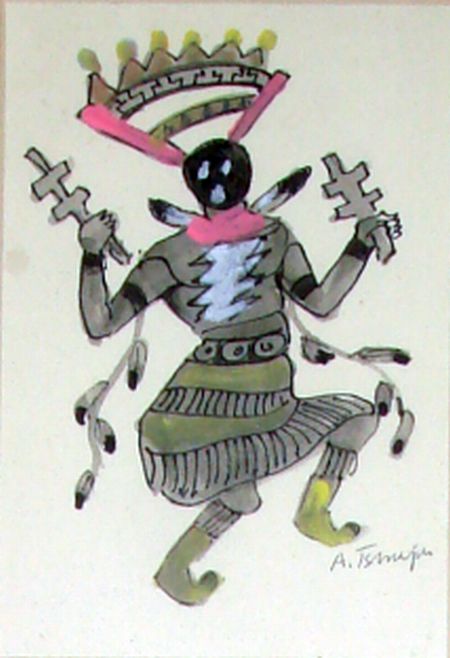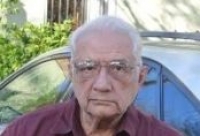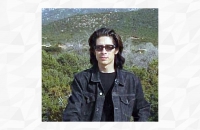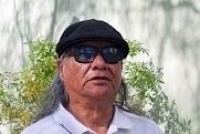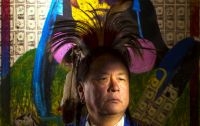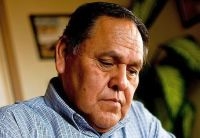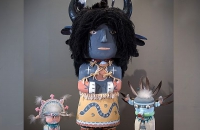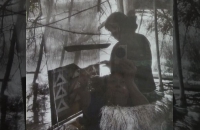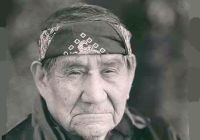“Apache Crown Dancer” is an original watercolor by Navajo artist Andrew Tsinajinnie. This 4” x 6” painting has an outer frame size of 9” x 11”.
Call for shipping
The Apache Crown Dancer is also known as the Mountain Spirit Dancer. They possess the ability to heal and have the power to blow away sickness. The Crown Dancers dance at night, bringing the spiritual world into physical manifestation.
Andy Tsinajinnie was born in Rough Rock Arizona in 1918. He studied the classic flat style painting under Dorothy Dunn at the Santa Fe Indian School. Andy’s paintings were known for their bold colors, and a favorite subject was the Navajo ceremonials and Navajo mythology, along with the whimsical side of Navajo reservation life. After serving in the Army in World War 11, he opened a studio in Scottsdale. Among numerous other awards, Andy was named an Arizona Living Treasure in 1991. His death November 7, 2000 was the end of an era.
About the artist
Andrew Van Tsinajinnie
Also Known as: Yazzie Bahe, Little Grey, Andy Tsinajinnie, Andy Tsinajinie, Andy Tsinajininie, Andy Tsinnaijinnie, Andy Van Tsinajinnie, Andrew Van Tsinajinnie, Andrew Van Tsinajinie, Andy Tsinahjinnie, Andrew Van Tsihnahjinnie……the artist went through many moods, solidifying a style momentarily then turning to something new and utterly different which may explain the different signatures. His subject matter stayed faithful to his heritage even as his style changed. He was chameleon-like in his ability to change and adapt. He is recognized as one of the finest of 20th Century Navajo artists.
Andy Tsinanjinnie was born on the reservation in Rough Rock near Chinle, Arizona in 1916. He was using stone-on-stone to draw until at the age of 5 when he discovered pencils. Then he drew on everything from wrapping paper to backs of labels producing charming drawings. He attended elementary school in Chinle, but ran away so many times he was sent to Fort Apache on the Apache Reservation. Tsinajinnie grew up herding sheep and riding horses and his love for that life was what he wanted to portray in his paintings, along with Navajo ceremonies.
He was one of the first pupils to receive art instruction at "The Studio", founded by Dorothy Dunn at the Santa Fe Indian School. In order to portray to what Dunn felt was authentic representation of Native American traditional art, The Studio art students were taught to paint in a flat, two dimensional style. He was an avid student and was known to have stayed in the studio painting until forced to return to the dormitory. Dorothy said that he was one of the best artists there. Following his graduation, he went to work as an illustrator for the Indian Service.
Shortly after graduation Andy received PWAP and WPA grants for large murals in Arizona and New Mexico. He also received private commissions for several large murals in other parts of the country.
In 1940 he joined the Army Air Force. He went to the Greenville Army Flying School in North Carolina where he was in the marching band. He was transferred to the South Pacific. He spent five years in the South Pacific and Asian Theaters. When he returned he opened a studio in Scottsdale, Arizona. Tsinajinnie made his living as a full time artist for the remainder of his life, which was almost cut short by a serious illness in the early 1970's. Tsinnijinnie’s work, which most often featured images of traditional Navajo life, appeared in numerous books and publications including "Arizona Highways" and "Navajo History, Volume I". He produced art work from the early 1940’s and continued until problems with his eyesight much later in life slowed his production.
Designated an Arizona Living Treasure, this fine artist has work included in the permanent collections of:
… the Denver Art Museum
… the Thomas Gilcrease Institute of American History and Art in Tulsa, Oklahoma
… the Heard Museum in Phoenix, Arizona
… the Museum of Northern Arizona in Flagstaff, Arizona
… the Philbrook Museum of Art in Tulsa
… the Millicent Rogers Foundation Museum in Taos, New Mexico
… the Smithsonian Institution in Washington, DC
… the Wheelwright Museum of the American Indian Art in Santa Fe, New Mexico
… the C.N. Gorman Museum, University of California, Davis
Tsinnijinnie’s best work is his portrayal of Navajo life and ceremonies. He is known for his attention to detail in paintings.

